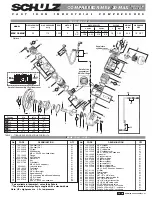
37
( )
Book: 22305593 (8/03)
To service the air cleaners on all units proceed as
follows:
1.
Release cover latches, and remove cover.
2.
Inspect air cleaner housing for any condition
that might cause a leak and correct as
necessary.
3.
Wipe inside of air cleaner housing with a clean,
damp cloth to remove any dirt accumulation,
especially in the area where the element seals
against the housing.
4.
Inspect element by placing a bright light inside
and rotating slowly. If any holes or tears are
found in the paper, discard this element. If no
ruptures are found, the element can be
cleaned.
5.
If a new air filter element is to be used check it
closely for shipping damage.
6.
Install cleaned or new elements in the reverse
order to the above.
7.
Install cover and fasten latches.
In the event that the filter element must be reused
immediately, compressed air cleaning (as follows) is
recommended since the element must be thoroughly
dry. Direct compressed air through the element in the
direction opposite to the normal air flow through the
element.
Move the nozzle up and down while rotating the
element. Be sure to keep the nozzle at least one inch
(25.4 mm) from the pleated paper.
NOTE: To prevent damage to the element, never
exceed a maximum air pressure of 100 psi (700
kPa).
In the event the element is contaminated with dry dirt,
oil or greasy dirt deposits, and a new element is not
available, cleaning can be accomplished by washing,
using the air cleaner element manufacturer’s
recommendations.
NOTE:
It is recommended that replacement elements
be installed in the unit. The elements just removed for
cleaning can be washed and stored as future
replacement elements.
In addition, the air cleaner system (housing and
piping) should be inspected every month for any
leakage paths or inlet obstructions. Make sure the air
cleaner mounting bolts and clamps are tight. Check
the air cleaner housing for dents or damage which
could lead to a leak. Inspect the air transfer tubing from
the air cleaner to the compressor and the engine for
leaks.
Make sure that all clamps and flange joints are tight.
GAUGES
The instruments or gauges are essential for safety,
maximum productivity and long service life of the
machine. Inspect the gauges and test any diagnostic
lamps prior to start--up. During operation observe the
gauges and any lamps for proper functioning. Refer
to Operating Controls, for the normal readings.
FUEL TANK
CLEAN fuel in the fuel tanks is vitally important and
every precaution should be taken to ensure that only
clean fuel is poured or pumped into the tank.
When filling the fuel tank on this unit, by methods other
than a pump and hose, use a CLEAN non--metallic
funnel.
BATTERY
Keep the battery posts--to--cable connections clean,
tight and lightly coated with a grease. Also the
electrolyte level in each cell should cover the top of the
plates. If necessary, top--up with clean distilled water.
TIRES
A weekly inspection is recommended. Tires that have
cuts or cracks or little tread should be repaired or
replaced. Monthly check the wheel lug nuts for
tightness.
Summary of Contents for P185WIR
Page 69: ...SECTION 11 PARTS LIST...
Page 70: ......
Page 71: ......
Page 72: ......
Page 73: ......
Page 74: ......
Page 75: ......
Page 76: ......
Page 77: ......
Page 78: ......
Page 79: ......
Page 80: ......
Page 81: ......
Page 82: ......
Page 83: ......
Page 84: ......
Page 85: ......
Page 86: ......
Page 87: ......
Page 88: ......
Page 89: ......
Page 90: ......
Page 91: ......
Page 92: ......
Page 93: ......
Page 94: ......
Page 95: ......
Page 96: ......
Page 97: ......
Page 98: ......
Page 99: ......
Page 100: ......
Page 101: ......
Page 102: ......
Page 103: ......
Page 104: ......
Page 105: ......
Page 106: ......
Page 107: ......
Page 108: ......
Page 109: ......
Page 110: ......
Page 111: ......
Page 112: ......
Page 113: ......
Page 114: ......
Page 115: ......
Page 116: ......
Page 117: ......
Page 118: ......
Page 119: ......
















































